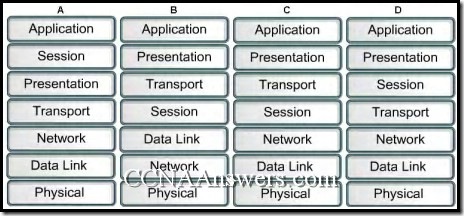CCNA 1 Module 2 V3.1 Answers
1. What is the term used to describe the transport layer protocol data unit?
bits
packets
segments
frames
data streams
2. Refer to the following list. Choose the correct order of data encapsulation when a device sends information.
1. segments
2. bits
3. packets
4. data
5. frames
1 - 3 - 5 - 4 - 2
2 - 1 - 3 - 5 - 4
2 - 4 - 3 - 5 - 1
4 - 3 - 1 - 2 - 5
4 - 1 - 3 - 5 - 2
3 - 5 - 1 - 2 – 4
3. Which two features apply to WAN connections? (Choose two.)
operate using serial interfaces
make network connection using a hub
limited to operation over small geographic areas
typically operate under local administrative control
provide lower bandwidth services compared to LANs
4. Which best describes the function of the physical layer?
Defines the electrical and functional specifications for the link between end systems.
Provides reliable transit of data across a physical link.
Provides connectivity and path selection between two end systems.
Concerned with physical addressing, network topology and media access.
5. What is one advantage of defining network communication by the seven layers of the OSI model?
It increases the bandwidth of a network.
It makes networking easier to learn and understand.
It eliminates many protocol restrictions.
It increases the throughput of a network.
It reduces the need for testing network connectivity.
6. A switch has failed in the network. As a result, only one segment of the network is down. Which type of physical network topology is implemented?
bus
ring
star
extended star
7. Which of the following are factors that determine throughput? (Choose two.)
types of passwords used on servers
type of Layer 3 protocol used
network topology
width of the network cable
number of users on the network
8. Which term describes the process of adding headers to data as it moves down OSI layers?
division
encoding
separation
segmentation
encapsulation
9. Which three features apply to LAN connections? (Choose three.)
operate using serial interfaces
make network connection using a hub
limited to operation over small geographic areas
provide part-time connectivity to remote services
typically operate under local administrative control
provide lower bandwidth services compared to WANs
10. Which of the following are data link layer encapsulation details? (Choose two.)
A header and trailer are added.
Data is converted into packets.
Packets are packaged into frames.
Frames are divided into segments.
Packets are changed into bits for Internet travel.
11. Which layer of the OSI model provides connectivity and path selection between two end systems where routing occurs?
physical layer
data link layer
network layer
transport layer
12. What makes it easier for different networking vendors to design software and hardware that will interoperate?
OSI model
proprietary designs
IP addressing scheme
standard logical topologies
standard physical topologies
13. The central hub has malfunctioned in the network. As a result, the entire network is down. Which type of physical network topology is implemented?
bus
star
ring
mesh
14. Which of the following are layers of the TCP/IP model? (Choose three.)
Application
Physical
Internet
Network Access
Presentation
15.

Refer to the exhibit. Identify the devices labeled A, B, C, and D in the network physical documentation.
A=bridge, B=switch, C=router, D=hub
A=bridge, B=hub, C=router, D=switch
A=bridge, B=router, C=hub, D=switch
A=hub, B=bridge, C=router, D=switch
16.

Refer to the exhibit. Which column shows the correct sequence of OSI model layers?
A
B
C
D
17. Which layer of the OSI model provides network services to processes in electronic mail and file transfer programs?
data link
transport
network
application
18. Which of the following are ways that bandwidth is commonly measured? (Choose three.)
GHzps
kbps
Mbps
Nbps
MHzps
Gbps




Leave a Reply